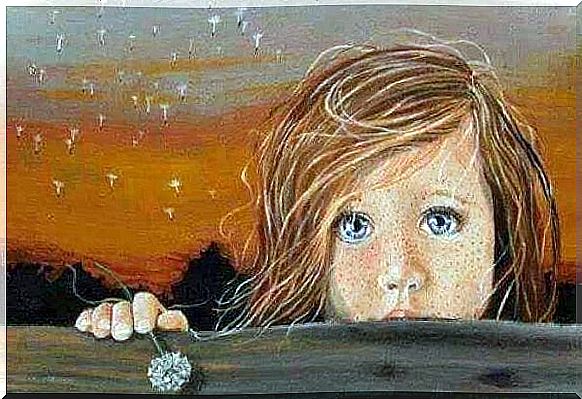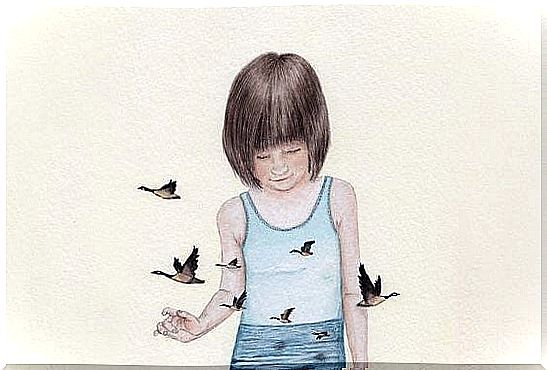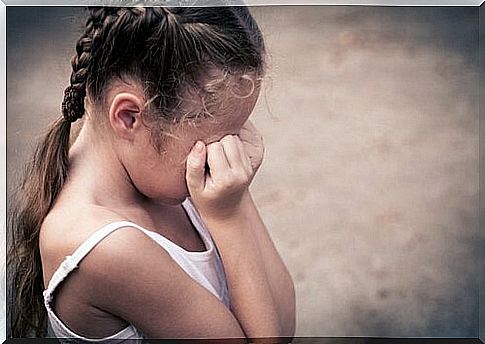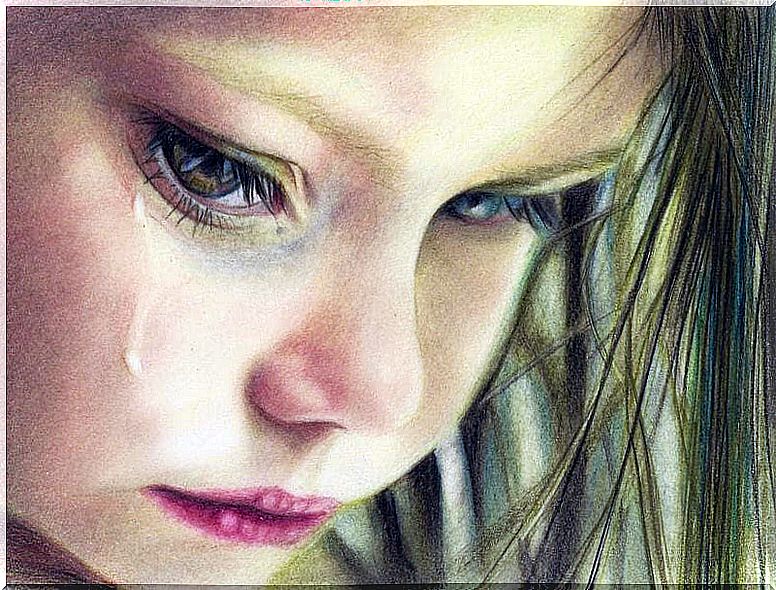Depression In Children: Children’s Tears Are Stabbing Right In The Heart

Depression in children exists, even though little is known about it. Sad children who cry, who don’t laugh, who get angry all the time and who don’t enjoy life. Children who live their lives drowning in torment. Children who see their innocence overshadowed by the terrible monster of depression.
For in the end there are indeed children who are in deep sorrow. Children who cannot laugh because their reality is responsible for pausing their innocence. It seems impossible. Because the image we have of childhood is one in which all children are laughing, happy and playful.
When we see children who are serious and depressed, we emphasize that they should not be sad. We tell them not to cry, but to laugh. This is the first big mistake.
A depressed child maintains an inner dialogue with itself that is rarely made explicit and visible. Some of the questions they ask themselves are: How can I force myself to feel better? Why do people insist that I laugh, play, don’t cry and never get angry? I can’t stop feeling annoyed, why is that? Why is everyone looking at me weird? Maybe I’m weird and it’s not even worth it.

Depression in children: a depression with visible features
Childhood depression exists and has distinctive signs that can help us recognize that something is not quite right in our children’s inner emotional lives. Some of these symptoms are similar to those found in adults. Sadness, for example, manifests itself regularly, as does a decline in academic performance. This is comparable to the low work performance seen in adults.
A distinguishing aspect, however, is that irritability and aggressiveness are common features in childhood depression. You will probably also hear somatic complaints such as abdominal pain, headache, muscle pain, etc.
We can also see how the darkness overshadows their motivation and desire to play or do other activities. You may also encounter children who do not eat or sleep well or suffer from a lack of overall energy.
A young person suffering from depression is usually unable to concentrate, think and make decisions. Instead, he may have thoughts of death or ideas, plans, or suicide attempts.
If you observe five or more of these symptoms listed, the specialist will likely diagnose depression. Nevertheless, you should also keep in mind that a certain state of apathy, reluctance or sadness is quite normal.

We should really respect a child’s apathy or sadness with caution. We often tend to tell them to try to be happy without understanding what is actually causing their discomfort. This means we convey the message that sadness, frustration and anger are not normal; that they are useless emotions.
Let’s think for a moment about what this implies for a child or an adult. Isn’t being sad after a loss normal? Do we not feel irritated at some point? Are these emotional states not helpful in the realization of certain things?
It is also possible that we may observe certain motor agitation in childhood depression, also known as agitated depression. The child can no longer sit still. It feels like the chair is burning its skin. He rubs his hands, at a constant speed, drums his fingers…

They seem to run on a battery that is always fully charged. This state should not be confused with hyperactivity. It is therefore always essential for professionals to observe any other symptom that may accompany this in order to make the correct diagnoses.
The counterpart of agitated depression can be seen in a so-called slow depression. The little one thinks, talks and moves in a slow manner. You can’t talk to him and you have to repeat each question over and over. His subjects are not varied and he remains quiet and calm for long periods of time.
Another punch line can be when the child has very low or poor self-esteem or self-confidence. The child may think he is worthless and flawed. He may also magnify the mistakes he makes.

Ten ideas to make a depressed child feel better
Francisco Xavier Mendez, a Spanish child psychologist, in his book The Child That Doesn’t Smile, gives ten ideas to stimulate laughter and pleasure in children who suffer from constant sadness.
- Lead by example: smile, be in a good mood, enjoy your free time and vacations, think out loud in a sensible way, etc.
- Help the child to have fun and feel good: plan enjoyable and fun activities, invite their friends, surprise them with innovative and attractive plans, emphasize their achievements, keep their preferences in mind.
- Protect them from unnecessary suffering: take care of their health (vaccinations, hygiene, sleeping habits, diet, etc.), prepare them for stressful situations (the start of a school year or the loss of a family member, for example).
- Promote a harmonious environment with the family and at home: express your love in words and deeds, promote communication between family members, avoid parental discussions in their presence, etc.
- Raise them with affection and coherence: behave appropriately to the environment, set reasonable rules of conduct and demand their cooperation, be complete and flexible, cooperate with school, etc.

- Stimulate their qualities, hobbies and interests: enroll them in a gym or association, awaken their interests in music, reading, theater, film, collecting, craft, etc. Encourage them to try enriching experiences such as new flavors, sports, games…
- Teach them how to deal with frustration: don’t give in to irrational demands, ignore their temperamental tantrums, teach them to wait their turn, gradually delay the satisfaction of delayed demands, progressively delay the gratification, let them have their toys and share property.
- Make them responsible, not guilty: value the effort they put into studying, not their grades or the awards they receive. Set realistic goals and congratulate them for achieving them (” Congratulations on your grades!” is better than ” Next time I want to see all A’s!” ).
- Mold a rational mindset: avoid labeling and absolute language (‘ You’re bad. You never do this’ ); Instead of providing the solution, let them think about it for themselves (” What can we do to solve this…? And what else?” ). Talk to them, refute their irrational ideas and beliefs, etc.
- Strengthen their autonomy: teach them basic skills such as washing and dressing themselves, cooking and how to handle money. Give them the opportunity to practice. Help them with everything they need, but don’t solve their problems for them. Gradually allow them into the decision making process.
However, if we continue to see any of the symptoms described above in children on a continuous basis, we should call in a specialist to evaluate the child. This will work on the aspects described above. And this will shine a light on the fantastic smile every child should have on their face and in their heart.
A child’s emotional health is not something that just magically appears. It’s something you have to cultivate. That’s why we must remember that it is easier to raise strong children than to fix broken adults.








